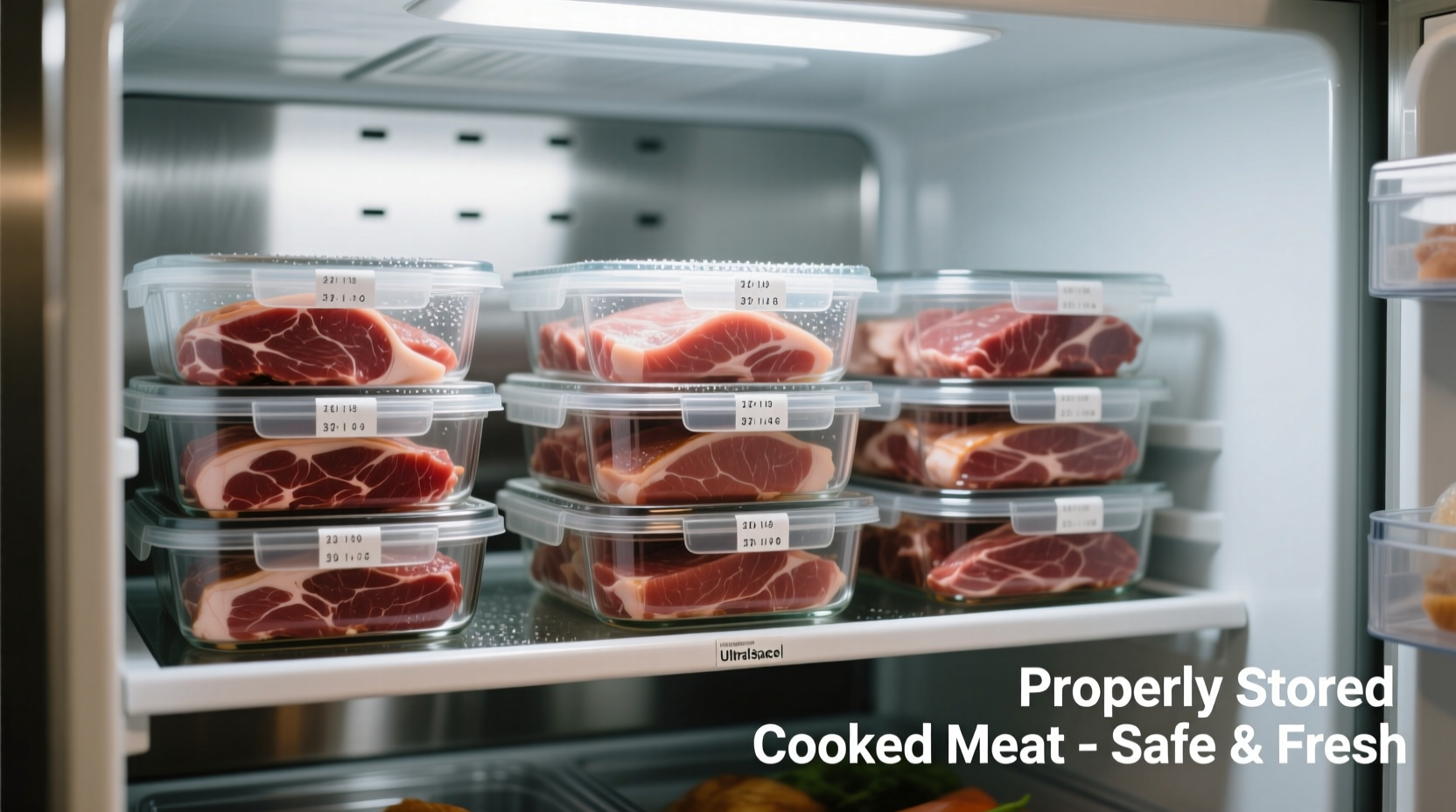Understanding proper cooked meat storage isn't just about avoiding food waste—it's a critical food safety practice that protects you and your family from potentially serious illness. Each year, 1 in 6 Americans suffers from foodborne illness, with improper food storage being a major contributing factor according to the Centers for Disease Control and Prevention.
Why the 3-4 Day Rule Matters for Cooked Meat Safety
When you cook meat, you destroy harmful bacteria present in raw products. However, once cooked meat cools to room temperature, it enters the "danger zone" between 40°F and 140°F where surviving bacteria multiply rapidly. Refrigeration slows this process but doesn't stop it completely.
The USDA Food Safety and Inspection Service emphasizes that cooked meat should never be kept longer than 4 days in standard home refrigerators. This recommendation applies regardless of whether the meat appears or smells normal—pathogenic bacteria often don't produce noticeable changes until dangerous levels are reached.
Storage Guidelines by Meat Type
While the 3-4 day rule applies broadly, certain cooked meats have slightly different safe storage windows based on their fat content and preparation method. The following table summarizes official recommendations from the USDA Food Safety and Inspection Service:
| Cooked Meat Type | Maximum Refrigerator Storage | Special Considerations |
|---|---|---|
| Cooked chicken or turkey | 3-4 days | Remove bones before storage to prevent faster spoilage |
| Cooked beef, pork, lamb | 3-4 days | Fattier cuts may spoil slightly faster than lean cuts |
| Cooked fish | 3 days | Fatty fish like salmon spoil faster than lean fish |
| Casseroles with meat | 3-4 days | Ensure even cooling before refrigerating |
| Meat gravies or broths | 2 days | High moisture content accelerates bacterial growth |
Proper Storage Techniques That Extend Freshness
How you store cooked meat significantly impacts its actual shelf life. Follow these evidence-based methods to maximize safety and quality:
- Cool rapidly—Divide large portions into shallow containers no deeper than 2 inches to cool within 2 hours (1 hour if room temperature exceeds 90°F)
- Air-tight containers—Use glass or BPA-free plastic containers with tight-fitting lids, or wrap securely in heavy-duty aluminum foil or freezer paper
- Refrigerator temperature—Maintain your refrigerator at 40°F (4°C) or below; use a refrigerator thermometer to verify
- Strategic placement—Store cooked meats on upper shelves, never in the refrigerator door where temperatures fluctuate

Signs Your Cooked Meat Has Spoiled
Don't rely solely on the calendar—always inspect cooked meat before consuming. The USDA identifies these clear indicators that cooked meat should be discarded immediately:
- Texture changes—Slimy or sticky surface that wasn't present when stored
- Odor changes—Sour, rotten, or unpleasant smell (though some bacteria don't produce odor)
- Visual changes—Mold growth in any color, or significant color change beyond normal oxidation
- Unusual taste—If it tastes "off" even if other signs aren't present
When in doubt, throw it out. The Food and Drug Administration emphasizes that you cannot smell or see all dangerous bacteria—pathogens like Listeria and Staphylococcus aureus often don't produce noticeable changes until they've reached dangerous levels.
Common Misconceptions About Cooked Meat Storage
Several persistent myths about cooked meat storage put consumers at risk. Let's examine what the evidence actually shows:
- "If it smells okay, it's safe to eat"—False. Pathogenic bacteria like Listeria don't always produce detectable odors.
- "Reheating makes old leftovers safe"—Partially false. While proper reheating (to 165°F) kills bacteria, it doesn't destroy heat-stable toxins produced by some bacteria.
- "The fridge stops all bacterial growth"—False. Refrigeration only slows growth; psychrotrophic bacteria continue multiplying at cold temperatures.
When Freezing Makes Sense for Cooked Meat
If you won't consume cooked meat within 3-4 days, freezing is your best option for long-term storage. The National Center for Home Food Preservation confirms that frozen cooked meat remains safe indefinitely, though quality declines over time:
- Cooked poultry and meat: 2-6 months for best quality
- Casseroles with meat: 3-4 months
- Gravies and broths: 2-3 months
For optimal results, remove air from freezer bags, label with contents and date, and freeze in portion sizes you'll actually use.
Special Considerations for Leftover Safety
Certain situations require extra caution with cooked meat storage:
- Leftovers from restaurants—Consume within 3 days, as you don't know how long they were held before packaging
- Catered events or buffets—Discard any cooked meat left at room temperature for more than 2 hours (1 hour above 90°F)
- Power outages—Keep refrigerator closed; food stays cold for about 4 hours. Discard cooked meat if temperature exceeds 40°F for 2+ hours
Reheating Leftovers Safely
Proper reheating technique matters as much as storage time. Follow these guidelines from the FDA Food Code:
- Reheat to an internal temperature of 165°F (use a food thermometer)
- Bring sauces, soups, and gravies to a rolling boil
- Stir food while reheating for even heat distribution
- Only reheat the portion you plan to eat immediately
Reducing Food Waste While Staying Safe
Understanding proper cooked meat storage helps balance food safety with waste reduction. Consider these practical strategies:
- Label containers with storage dates using masking tape
- Follow "first in, first out" principles—place newer items behind older ones
- Transform aging leftovers into new dishes (e.g., chicken salad from cooked chicken)
- Freeze portions you won't eat within 3 days











 浙公网安备
33010002000092号
浙公网安备
33010002000092号 浙B2-20120091-4
浙B2-20120091-4